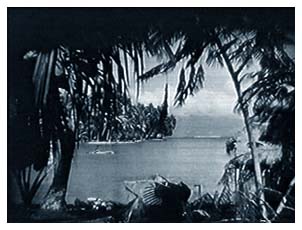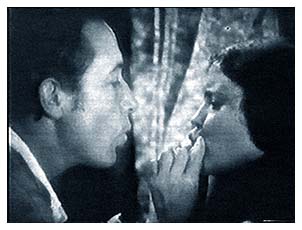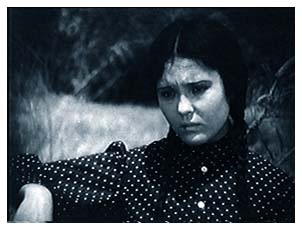

A Cosmopolitan Production
Distributed by M.G.M.
Directed by W. S. Van Dyke and Robert Flaherty
Scenario by Jack Cunningham, from the novel of the same title
by Frederick J. O'Brien
Titles and dialogue by John Colton
Adaptation by Ray Doyle
Cinematography by Clyde De Vinna, George Nagle and Bob Roberts
Edited by Ben Lewis.
Cast: Monte Blue (Dr. Matthew Lloyd), Raquel Torres (Fayaway), Robert Anderson (Sebastian)
In reviewing articles on the genesis
of this film, it is difficult to determine where to lay credit
and blame. Flaherty proponents seem to consider the title (and
Flaherty's tenure as its director) to be a victim of the crass
commercialism of the studio system. Van Dyke advocates would protest
that Flaherty was not attuned to the needs of telling a dramatic
story and that an understanding and appreciation of the peoples
of the film's South Seas Island location was not enough to attain
success in the production of a narrative film.
It seems likely to me that the idea of hiring the director of the acclaimed documentary MOANA OF THE SOUTH SEAS to return to that region to tell another story of its people was a seemingly good idea that just didn't work out. As author O'Brien had pointed Flaherty to Samoa for the earlier film, it seemed reasonable for M-G-M to hire the filmmaker to bring his friend's story to the screen; appointing Woody Van Dyke to act as co-director would provide someone with authority on the project who had experience with outdoor pictures (albeit Westerns) and with more traditional narrative film.
It isn't clear from my readings whether Flaherty's departure from the project was due to his dissatisfaction with the restrictions of non-documentary filmmaking, M-G-M's dissatisfaction with his progress on completing the picture or a combination of these factors. It seems undisputed that, after six months in Tahiti, Flaherty had produced only a modest amount of completed footage, while Van Dyke had long since finished the portions of the picture he had been assigned to provide. Time being money, this was a situation the front office was unlikely to ignore.
Robert C. Cannom writes in his book Van Dyke and the Mythical City, Hollywood, "by a fluke, Van Dyke found himself saddled with the greatest responsibility of his career. But he hadn't been caught napping. This was the opportunity he had fought and hoped for. Van Dyke didn't believe in breaks. He knew there were several back at the studio who didn't like him or think him capable of handling this type of story. He hadn't wasted a minute since he set foot on the Island, and when his opportunity came, he was ready for it. He knew every line of that story from start to finish, and what's more, had every scene worked out in his own mind."
William K. Everson wrote "Flaherty's supporters all dismiss Van Dyke scornfully because he was a slick director who made films fast and economically and without displaying any directorial temperament. This, they hinted, removed any consideration of artistry in his work. I would have thought that those qualities were definite virtues, especially when allied to the work Van Dyke turned out with such amazing regularity. Take a look today at his TRADER HORN and THE THIN MAN and see if you don't agree that they stand up beautifully!"
Unscrupulous trader Sebastian has
little trouble cheating the inhabitants of the South Seas paradise
and leading the natives to adopt some of  the
more unfortunate habits of "civilized" men. He has little
opposition save Dr. Matthew Lloyd, once an educated and prominent
physician but now smothered in the depths of alcoholic deterioration.
When Lloyd goes too far in his attempts to thwart the success
of the trader's greedy plots, Sebastian sees to it that the doctor
is framed for a crime and sentenced to be cast adrift tied to
the wheel of a derelict ship.
the
more unfortunate habits of "civilized" men. He has little
opposition save Dr. Matthew Lloyd, once an educated and prominent
physician but now smothered in the depths of alcoholic deterioration.
When Lloyd goes too far in his attempts to thwart the success
of the trader's greedy plots, Sebastian sees to it that the doctor
is framed for a crime and sentenced to be cast adrift tied to
the wheel of a derelict ship.
His ship caught in a typhoon, Lloyd is shipwrecked--freed from the ship's wheel--and washed ashore on another island as yet untouched by the "White Shadows." He is rejuvenated by the pristine environment and the innocent people, who embrace him as a god. But the corruption of civilization is too close and the world too small for paradise to be eternal.
The New York Times critic wrote, "Whether it is dangerous to stress the white man's failings and the nobleness of the savage in an age which no longer cares about such things remains to be seen...it is no longer the thing to point out that civilization is amiss, that the uncultivated and rough peoples in the far away corners of the earth have found a happiness--merely through their primitiveness--that the educated cannot reach."
Variety observed, "For those who liked NANOOK, CHANG, MOANA, etc., WHITE SHADOWS is sure. For regular picture house audiences its opening wallop and the consistently high grade photography, plus the native customs, figure to make it a worthwhile transgression from the stereotyped clinch finish."
copyright 2001 by Steven Haynes, all rights reserved.
additional comments by Tim Lussier
"White Shadows of the South Seas" is beautiful pictorially, but also beautiful in its story, although it clearly depicts the baser, disgusting side of man. Greed is the overriding theme, and a compelling picture of its power is given as it destroys the purity of the life of the natives.
The viewer sympathizes with Dr. Matthew
Lloyd in the opening scenes as he shows his disgust at how Sebastian
(representative of white men in general) has come to this remote
South Seas island and totally changed the life of these natives.
They have been transformed into slaves of commercialism  who risk their lives harvesting pearls, which
are of no value to them, to satisfy Sebastian's greed. Doc Lloyd's
outspokenness is a threat to Sebastian, and he arrnages to have
him removed from the island, hopefully to die adrift at sea. Instead,
Lloyd is shipwrecked on another island where the natives have
never even seen a white man. It is truly paradise. But, as if
to tell us that some things in this world are inevitable, Sebastian
eventually finds this island, as well. The irony, however, is
that Doc Lloyd is indirectly the cause of Sebastian's arrival.
who risk their lives harvesting pearls, which
are of no value to them, to satisfy Sebastian's greed. Doc Lloyd's
outspokenness is a threat to Sebastian, and he arrnages to have
him removed from the island, hopefully to die adrift at sea. Instead,
Lloyd is shipwrecked on another island where the natives have
never even seen a white man. It is truly paradise. But, as if
to tell us that some things in this world are inevitable, Sebastian
eventually finds this island, as well. The irony, however, is
that Doc Lloyd is indirectly the cause of Sebastian's arrival.
As with any good picture, it is an emotional one and pulls the viewer in emotionally, as well. By contrasts, we have been shown what damage the white man can do in the opening scenes, and then we are shown what life is like for these natives without the intrusion of the white man. When Sebastian arrives like a cancer spreading throughout any remote area that has yet been untouched, we want to see Doc Lloyd dispose of him. Somehow, some way, someone must win out over this man. Yet, that would have been a little too cliché. No, it's not a happy ending, but it's a moving ending, an emotional one - one that leaves you thinking long after the film has ended.
William K. Everson (American Silent Film, Oxford University Press, 1978) describes "White Shadows in the South Seas" as "totally lyrical." Welford Beaton in The Film Specatator (June 23, 1928) said, "Nothing finer . . . has ever come to the screen." Motion Picture magazine (September, 1928) called it "ravishing to the eye and appealing to the heart." It is a fine film, beautifully photographed, with high production values, and a story that is sensitive and moving. This is another excellent example of the zenith silent film had reached prior to the coming of sound.